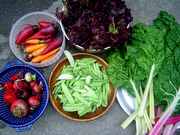

|
| Vegetable Varieties for Gardeners is a citizen science program
|
|
|
|
'White Lady' Turnips |
| |
| Sub-Category: |
None
|
| |
|
| Sub-Category 2: |
| | Description: |
Hybrid. Dark green, 20-inch plants produce pure white, semi-round, 2 1/2-inch roots. Bolt tolerant.
|
| Days To Maturity: |
35
|
| Seed Sources: |
|
| |
| Rating Summary |
| |
Overall: (5.0 Stars)
Taste: (5.0 Stars)
Yield: (5.0 Stars)
Ease/Reliability: (4.5 Stars) |
| |
| Reviews |
| |
Login to share your Review of White Lady.
Number of Reviews: 2
KEY: O=Overall Rating, T=Taste, Y=Yield, E=Ease
Reviewed on 10/29/2009 by
farmerdill
- An experienced gardener
|
 Overall Overall
 Taste Taste
 Yield Yield
 Ease Ease
|
Richmond, Georgia, United States
Frost Free Season: 183 - 203 days
Soil Texture: Sand
Garden Size: Large - More than 1,600 square feet (40' x 40')
Sun Exposure: More than 8 hours per day
|
| A very uniform, productive turnip under my conditions. It is milder than Purple Top/White Globe but has excellent flavor in its own right. Cooked southern style, tops plus cubed turnips seasoned with a ham hock and served with pepper vinegar. delicious |
| |
|
Reviewed on 01/16/2007 by
California Olive
- An experienced gardener
|
 Overall Overall
 Taste Taste
 Yield Yield
 Ease Ease
|
California, United States
Frost Free Season: More than 203 days
Soil Texture: Clay
Garden Size: Large - More than 1,600 square feet (40' x 40')
Sun Exposure: More than 8 hours per day
|
| Almost as sweet and flavorful as the delicate, juicy little "salad turnips" Hakurei and Oasis. A little more vigorous for me, especially compared to Hakurei (though I haven't grown it side-by-side with the other two). All three have attractive roots and have the best quality when picked fairly small.
All three of the 'salad turnips' above are considerably earlier, sweeter and more tender than the spicier 'Purple Top White Globe' types. The latter are better storage turnips. The older types may be better cooked, though I seldom cook turnips except to put one or two in soup. All three of the 'salad turnips' above have hairless, sweet greens which I much prefer to the very pronounced flavor of the greens of older varieties of turnips. I don't like the little prickly hairs on the leaves of the older types, either. Though if you intend to cook turnip greens for a long time in the old-fashioned Southern style, the flavor of older types stands up better (their flavor mellows a lot with long cooking). You need to remove the tough midrib of White Lady, Hakurei or Oasis if you prefer to cook them briefly. Unless very young, the leaves are a little chewy for salads, though mild enough to eat raw.
Tokyo Cross still beats all of the turnips above for mildness and earliness, though it is not as sweet or flavorful as the three salad turnips above. All turnips have better quality in fall in our climate most years. Fall turnips do best when planted in September here. Tokyo Cross may be the best bet for mild flavor in spring. And it is so early that it reportedly sometimes misses out on the root maggot damage which can be a real problem in growing turnips. |
| |
|
|
|
|
Vegetable Varieties for Gardeners is a citizen science program, © 2004-2024, All Rights Reserved
Cornell Garden Based Learning, Cornell University College of Agriculture & Life Sciences, Horticulture Section
|






 VVfG home
VVfG home
 Ease
Ease